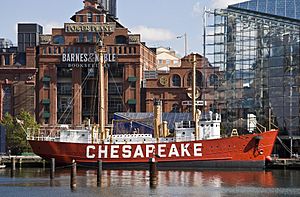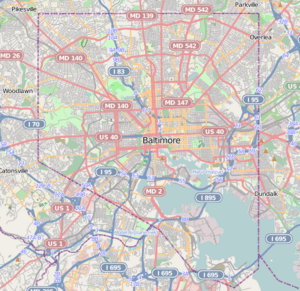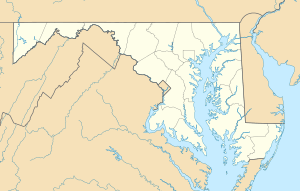United States lightship Chesapeake (LV-116) facts for kids
 |
|
| History | |
|---|---|
| Owner |
|
| Builder | Charleston Drydock & Machine Co., Charleston, South Carolina |
| Cost | $274,434 |
| Laid down | 6 February 1929 |
| Launched | 22 October 1930 |
| Acquired | 23 June 1930 |
| Commissioned | 1930 |
| Decommissioned | 6 January 1971 |
| Reclassified |
|
| Status | Museum ship |
| General characteristics | |
| Type | Lightship |
| Displacement | 130 long tons (132 t) |
| Length | 133 ft 3 in (40.61 m) |
| Beam | 30 ft (9.1 m) |
| Draft | 13 ft 9 in (4.19 m) |
| Propulsion | Diesel-electric, 350 hp (261 kW) |
| Speed | 9 knots (17 km/h; 10 mph) |
| Complement | 10 seamen, 5 officers, 1 cook |
| Armament | 2 × 20 mm rapid fire machine guns (World War II only) |
|
Chesapeake (lightship)
|
|
| Location | Inner Harbor, Baltimore, Maryland |
| Area | 0.1 acres (0.040 ha) |
| Built | 1930 |
| Architect | Green, Lewis, II; Charleston Drydock & Machine Co. |
| NRHP reference No. | 80000349 |
| Significant dates | |
| Added to NRHP | 1 August 1980 |
| Designated NHL | 20 December 1989 |
The United States lightship Chesapeake is a special kind of ship called a museum ship. It is owned by the National Park Service. Currently, it is on loan to Baltimore City and is looked after by Historic Ships in Baltimore, Maryland.
This ship is a National Historic Landmark. It is one of only a few lightships that have been saved. Since the 1820s, many lightships have worked at the Chesapeake lightship station. They were all called Chesapeake.
Lightships often moved from one station to another. When they moved, their "name" changed to the new station's name. But the ship's hull number, like LV-116, always stayed the same. The United States Coast Guard gave new hull numbers to all lightships in 1950. So, Light Ship 116 became WAL-538. In 1965, it changed again to WLV-538.
The Chesapeake had many backup systems to help it stay in place during storms. Its main anchor weighed 5,000 pounds (2,300 kg). There was a second anchor of the same weight. The main light was very bright, 30,000 candela[convert: unknown unit], and also had a backup lamp. Even the Radio Locator Beacon had a spare system. Sometimes, during big storms, the main anchor chain broke. This happened in 1933, 1936, and 1962. When this happened, the ship had to use its engines and drop its second anchor to stay put.
Contents
Building and Early Life of the Chesapeake
This lightship was built at the Charleston Dry Dock & Machine Company in Charleston, South Carolina. It cost $274,434.00 to build. Work on the ship started on February 6, 1929. It was launched into the water on October 22, 1930. The ship was ready and delivered on June 23, 1930.
The Chesapeake would take on the name of the station where it was anchored. In 1939, the ship became part of the United States Coast Guard. This happened to all ships that belonged to the United States Lighthouse Service.
Serving in the Coast Guard
When sailors joined the US Coast Guard, their pay was cut. They also had to pass Coast Guard health checks. And they had to wear uniforms. Coast Guard officers took charge of the lightships. This made the ships run more smoothly and strictly. But it also meant the crew got better supplies and training.
During World War II, the Chesapeake was based in Sandwich, Massachusetts. It worked as a guard ship at the north entrance of the Cape Cod Canal. It helped protect the important port of Boston.
Changes and Retirement
In the 1960s, new technology arrived. Automated buoys and permanent light stations started to replace lightships. So, the fleet of lightships slowly began to retire.
The Chesapeake left its station at the mouth of the Chesapeake Bay in September 1965. A large, manned light tower took its place. This tower was like an oil rig and could be reached by helicopter. It was easier to keep up than a lightship. Later, this light tower also became fully automated. Eight more lightships were built after the Chesapeake.
The Chesapeake served its last duty at the mouth of the Delaware Bay. This was from 1966 to 1970. There, it was called "DELAWARE." A huge, 104-ton buoy beacon replaced it in 1970.
After leaving Delaware Bay, the Chesapeake was docked in Cape May, New Jersey. It stayed there until it was officially retired on January 6, 1971. Then, it was given to the National Park Service. It was used as a floating classroom for learning about the environment. In 1982, it was given to the city of Baltimore.
Chesapeake as a Museum Ship
In 1988, the Chesapeake became part of the Baltimore Maritime Museum. This museum is now called Historic Ships In Baltimore. The ship is docked at Pier 3 in Baltimore's Inner Harbor. You can visit the ship after paying for admission to the museum.
The Chesapeake was added to the National Register of Historic Places on August 1, 1980. It was named a National Historic Landmark on November 20, 1989. The Chesapeake and other ships are important parts of the Baltimore National Heritage Area.
Where the Chesapeake Served
The Chesapeake had different names and stations during its time:
- FENWICK, at Fenwick Island Shoal, Delaware (1930–1933)
- CHESAPEAKE, at Chesapeake, Virginia (1933–1942)
- LS-116, as an Examination and Guard Vessel during World War II in Sandwich, Massachusetts (1942–1945)
- CHESAPEAKE, again at Chesapeake, Virginia (1945–1965)
- DELAWARE, at Delaware Bay, Delaware (1966–1970)
Images for kids





